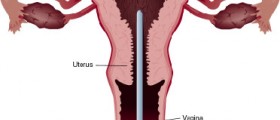
Some women have no symptoms, and will not even find out they have adenomyosis. Most have heavy menstrual bleeding, painful menstruation, pain during sex and sharp abdominal pains at random times. In addition, women who suffer from adenomyosis often experience bleeding in between two periods, and may pass blood clots during their menstruation. The cause of adenomyosis is still unclear. What is known, though, is that it almost always goes away after the menopause. Some say that childbirth is linked to adenomyosis, but women who have not had any children can get it too. A cesarean section is also said to increase a woman's risk of adenomyosis.
One theory is that the root of adenomyosis is actually during pregnancy in other words, that it is while the patient was still in the womb herself. Diagnosis can take place through a pelvic examination, ultrasound technology, or an MRI scan or indeed a combination. An endometrial biopsy can also be carried out in some instances.In most cases adenomyosis has no ill effect on a woman's overall health. It can be treated with anti-inflammatory or hormonal medications or solved with a hysterectomy in extreme cases.

















Your thoughts on this
Loading...